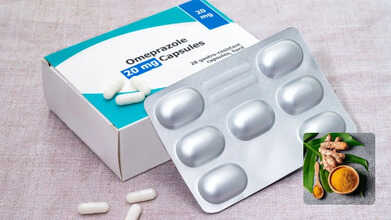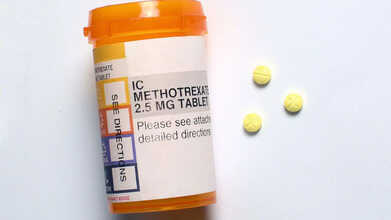- Health Conditions A-Z
- Health & Wellness
- Nutrition
- Fitness
- Health News
- Ayurveda
- Videos
- Medicine A-Z
- Parenting
Can’t Poop Or Too Much? Natural Remedies for Constipation and Diarrhea That Actually Work

Image Credits: Canva
We've all experienced digestive discomfort—whether it’s the frustration of constipation or the urgency of diarrhea. These common bowel issues can be a minor inconvenience or a sign of an underlying condition. While they usually resolve on their own, chronic irregularities in bowel movements can impact daily life, causing discomfort, bloating, and even dehydration.
Your digestive health plays a crucial role in overall well-being. Whether you’re dealing with occasional constipation or mild diarrhea, simple lifestyle changes can make a big difference. If problems persist, don’t hesitate to consult a healthcare provider for guidance.
Understanding what causes constipation and diarrhea, how they are connected, and how to manage them effectively is key to maintaining a healthy digestive system. Here’s everything you need to know about these common gut problems and practical solutions to restore balance.
What is Diarrhea? Symptoms and Causes
Diarrhea is characterized by loose, watery stools that occur more frequently than normal. While occasional diarrhea is usually harmless, persistent diarrhea can lead to dehydration and nutrient deficiencies. Common symptoms include:
- Watery or loose stools
- Urgent need to defecate
- Stomach cramps and bloating
- Nausea or an upset stomach
In severe cases, diarrhea may also cause:
- Fever
- Vomiting
- Blood or mucus in stool
- Severe abdominal pain
What Triggers Diarrhea?
Diarrhea can be caused by a variety of factors, including:
Infections – Bacterial, viral, or parasitic infections from contaminated food or water.
Food Intolerances – Lactose intolerance or sensitivities to artificial sweeteners.
Medications – Certain antibiotics and medications can upset gut bacteria.
Stress and Anxiety – Emotional stress can disrupt digestion.
Digestive Disorders – Conditions like irritable bowel syndrome (IBS) and Crohn’s disease.
What is Constipation? Symptoms and Causes
Constipation occurs when bowel movements become infrequent or difficult to pass. While pooping patterns vary among individuals, having fewer than three bowel movements a week is typically considered constipation. Symptoms include:
- Difficulty passing stool
- Hard, dry stools
- Straining during bowel movements
- Feeling of incomplete evacuation
- Bloating, gas, and abdominal discomfort
Common Causes of Constipation
Low Fiber Diet – Not consuming enough fiber from fruits, vegetables, and whole grains.
Dehydration – Lack of water makes stool hard and difficult to pass.
Sedentary Lifestyle – Physical activity helps stimulate the digestive system.
Medications – Certain painkillers, antidepressants, and iron supplements can slow digestion.
Stress and Anxiety – Mental health affects gut function.
Underlying Medical Conditions – Hypothyroidism, diabetes, and neurological disorders.
How Constipation Can Lead to Diarrhea?
It may seem counterintuitive, but severe constipation can sometimes result in diarrhea, a condition known as overflow diarrhea or paradoxical diarrhea. When stool becomes impacted in the intestines, only liquid waste can seep around the blockage, leading to watery stool.
Additionally, conditions like IBS can cause alternating bouts of constipation and diarrhea. If you frequently experience both symptoms, consult a healthcare provider for a proper diagnosis and treatment plan.
Natural Remedies to Relieve Constipation
If you’re struggling with constipation, there are natural ways to stimulate bowel movements:
Increase Water Intake – Drink an extra 2-4 glasses of water daily to soften stool.
Boost Fiber Consumption – Incorporate fiber-rich foods like leafy greens, chia seeds, and whole grains.
Try Prunes or Prune Juice – A natural laxative, prunes contain sorbitol, which helps soften stool.
Exercise Regularly – Physical activity stimulates bowel movements.
Establish a Routine – Try to use the bathroom at the same time each day.
Avoid Caffeine and Alcohol – Both can contribute to dehydration, worsening constipation.
Limit Distractions – Avoid using your phone or reading while in the bathroom; focus on relaxation.
At-Home Treatments for Diarrhea
When dealing with mild diarrhea, focus on staying hydrated and eating foods that help firm up stool:
Drink Plenty of Fluids – Water, electrolyte-rich drinks, and herbal teas prevent dehydration.
Follow the BRAT Diet – Bananas, rice, applesauce, and toast help solidify stool.
Avoid Dairy and Gas-Producing Foods – Dairy can worsen symptoms, and foods like beans and carbonated drinks cause bloating.
Consume Probiotics – Yogurt and fermented foods help restore gut bacteria.
When to See a Doctor
While occasional constipation and diarrhea are common, prolonged or severe symptoms may indicate an underlying condition. Seek medical attention if you experience:
- Diarrhea lasting more than two days
- Persistent constipation despite dietary and lifestyle changes
- Severe abdominal pain
- Blood in stool
- Unexplained weight loss
Omeprazole Alternative? Experts Point To A Kitchen Spice That May Ease Acid Reflux

Credits: Canva
A doctor has highlighted a common kitchen spice that may work just as effectively as omeprazole in relieving heartburn, acid reflux, and indigestion. Omeprazole is often prescribed for these conditions as a Proton Pump Inhibitor (PPI), helping to reduce the amount of acid produced in the stomach.
About 15% of the UK population takes a PPI like omeprazole. In England alone, over 73 million PPI prescriptions were issued in 2022–23, with omeprazole among the most commonly prescribed.
What Is Omeprazole Used For?
Omeprazole is a drug that lowers the amount of acid the stomach produces. Part of a class of medicines called proton pump inhibitors (PPIs), it is used to treat and prevent a range of acid-related problems, as per Mayo Clinic.
The length of treatment with omeprazole, as advised by your doctor, depends on the condition being treated and the prescribed dosage. Following your healthcare provider’s instructions and completing the full course of medication, even if symptoms improve, is important.
However, long-term use of omeprazole can increase the risk of various health issues, making regular consultations with your GP important, reports the Mirror. Prolonged acid suppression and changes in gut bacteria caused by extended use can result in several complications.
Lower stomach acid can reduce the body’s ability to absorb key nutrients, potentially causing deficiencies in magnesium, vitamin B12, calcium, and iron. Long-term use may also raise the risk of bone fractures and kidney problems. Other possible issues include growths in the stomach, dementia, and liver or heart problems.
Suppressing stomach acid, which normally kills harmful bacteria, can make the body more prone to infections such as community-acquired pneumonia or Clostridioides difficile infection, which causes severe diarrhoea and stomach pain.
Omeprazole Alternative: What Is The Spice, And How Can It Help?
Experts suggest that one kitchen spice could match omeprazole’s effectiveness while avoiding its health risks. Dr Michael Ruscio, DC, DNM, says curcumin, the active compound in turmeric, may be “just as effective,” according to research.
Dr Ruscio, a naturopathic practitioner, clinical researcher, and author, has published work in peer-reviewed medical journals. He is the Chief Health Officer and Head of Research at RIFM, and Founder and CEO of DrRuscio.com.
In a YouTube video for his 145k subscribers, Dr Ruscio explained that curcumin may help manage heartburn and acid reflux without relying on PPIs. He said: “Let me show you an important study demonstrating the power of anti-inflammatory interventions. You’ve probably heard of curcumin, this anti-inflammatory spice. A 2023 randomized control trial compared omeprazole to curcumin at two grams per day for one month.”
Quoting the study, “Curcumin and omeprazole showed similar effectiveness for functional dyspepsia,” a term covering symptoms like fullness, GORD, and indigestion. Dr Ruscio added, “It’s remarkable that curcumin, which also has benefits such as reducing joint pain, can be as effective as omeprazole. And it doesn’t carry the long-term risks of acid suppression that come with omeprazole.”
Curcumin’s anti-inflammatory and antioxidant properties may reduce oesophageal inflammation caused by stomach acid. Animal studies suggest it can protect the stomach lining from damage caused by certain medications and other irritants.
What Did The Study's Findings Reveal?
The referenced research, published in BMJ Journals as “Curcumin and proton pump inhibitors for functional dyspepsia: a randomized, double-blind controlled trial,” found that a daily dose of curcumin provided relief from functional dyspepsia symptoms comparable to omeprazole.
No significant side effects were observed, though liver function tests showed some decline in overweight participants taking curcumin. The researchers noted limitations including the short study period and lack of long-term data.
They concluded, “This multicentre randomized controlled trial provides strong evidence for treating functional dyspepsia.”
Functional dyspepsia, or chronic indigestion, occurs as persistent or recurring discomfort in the upper abdomen. Symptoms may include bloating, burping, nausea, or feeling full too quickly, often signaling issues in the oesophagus, stomach, or duodenum.
Despite promising results, it is essential to consult your doctor before making major changes to your diet or replacing prescribed medication with supplements. A discussion with your GP can help identify the most effective approach to managing your health.
What Else Is Curcumin Good For?
Curcumin is a powerful antioxidant that neutralizes free radicals, which can damage cells and contribute to ageing and illnesses like heart disease and cancer. Studies suggest it may relieve symptoms of osteoarthritis and rheumatoid arthritis, easing joint pain, stiffness, and inflammation.
Some research indicates curcumin may be as effective as certain nonsteroidal anti-inflammatory drugs (NSAIDs) for pain relief.
It may also support brain health by raising levels of brain-derived neurotrophic factor (BDNF), a hormone important for memory and learning. Researchers are investigating its potential to protect cognitive function with age and against conditions like Alzheimer’s.
Additionally, curcumin’s anti-inflammatory and antioxidant effects, along with possible benefits for cholesterol and blood pressure, may reduce the risk of heart disease.
Taking Methotrexate For Arthritis? Doctors Explain The Risks Behind The Latest Warning

Credits: Canva
People who take methotrexate for different health conditions have been cautioned by the NHS that certain symptoms and side effects should not be ignored and may require urgent medical help, including a visit to A&E or calling 999. Methotrexate works as an immunosuppressant, meaning it dampens the immune system to help control inflammation in the body.
What Is Methotrexate?
Methotrexate belongs to a group of medicines known as antimetabolites. It helps manage rheumatoid arthritis by dampening the body’s immune response, controls psoriasis by slowing the rapid buildup of skin cells, and is used in cancer treatment to limit the growth and spread of cancer cells, as per Mayo Clinic.
Doctors commonly prescribe it for conditions such as rheumatoid arthritis, Crohn’s disease, and psoriasis. In some situations, it is also used as part of cancer treatment. Methotrexate is usually taken as a tablet, a liquid medicine that is swallowed, or as a pre-filled pen or syringe that is injected under the skin. While many people benefit from the drug, it can also cause serious side effects that may be worrying for some patients.
Side Effects Of Methotrexate And When To Call For Emergency?
Certain severe side effects linked to methotrexate are rare and affect fewer than 1 in 10,000 people. Even so, the NHS advises contacting your doctor or calling 111 if you notice any of the following symptoms:
- Swelling in the hands, feet, or ankles along with shortness of breath, which may point to a kidney issue
- A long-lasting cough, chest discomfort, or trouble breathing, which could suggest lung inflammation
- Yellowing of the skin or the whites of the eyes, which can indicate liver damage
- Bleeding gums, vomiting blood, unexplained bruises, or blood in the urine, which may signal a blood disorder
- A high temperature, sore throat, or body aches, which could be signs of an infection
Symptoms of this can include:
- Swelling of the lips, throat, or tongue
- A tight sensation in the throat or difficulty swallowing
- Confusion
- Collapsing or fainting and being hard to wake
- Skin, lips, or tongue turning blue, pale, or grey
- Very rapid breathing or severe difficulty breathing
Methotrexate: What Should You Watch Out For While Taking This Medication?
See your care team regularly so they can monitor how the treatment is working. It may take a while before you notice any improvement. You may be asked to get routine blood tests during the course of treatment.
If your care team has prescribed folic acid along with methotrexate, they may advise you not to take folic acid on the same day as your methotrexate dose.
This medicine can make your skin more sensitive to sunlight. Try to stay out of direct sun exposure. If that is not possible, wear covered clothing and apply sunscreen. Avoid sun lamps, tanning beds, or tanning booths.
Contact your care team if you have severe diarrhea, ongoing nausea or vomiting, or heavy sweating. Losing too much fluid from your body can make this medicine unsafe. This drug can raise your chances of developing an infection. Call your care team if you develop a fever, chills, sore throat, or flu-like symptoms. Do not self-medicate. As far as possible, stay away from people who are unwell.
Discuss your cancer risk with your care team. Long-term use of this medication may increase the risk of certain cancers.
Speak to your care team if you or your partner could become pregnant. Methotrexate can cause serious birth defects if taken during pregnancy or within six months after the last dose. A negative pregnancy test is required before starting treatment. Reliable contraception should be used while on this medication and for six months after stopping it. Your care team can guide you on suitable options.
If your partner can become pregnant, use condoms during sexual activity while taking this medication and for three months after the final dose. Do not breastfeed while using this medication and for at least one week after the last dose.
This medication may affect fertility. If this is a concern, discuss it with your care team.
Bemotrizinol: FDA Proposes New Sunscreen Ingredient—Here’s Why It Matters

Credits: Canva
America is aiming to align with global trends in sun protection. On December 11, the Food and Drug Administration proposed allowing the use of bemotrizinol in sunscreens — an ingredient that has been widely used in other countries for years.
Bemotrizinol provides stable, long-lasting defence against both types of UV rays that can harm the skin. According to the FDA announcement, it is gentle enough to be safe for young children and could be on shelves in time for next summer.
"The agency has historically moved too slowly in this area, leaving Americans with fewer options than consumers abroad. We’re continuing to modernize the regulation of sunscreen and other over-the-counter drug products,” FDA Commissioner Marty Makary said in a press statement. “Americans deserve timely access to the best safe, effective, and consumer-friendly over-the-counter products available.”
What is Bemotrizinol?
Bemotrizinol, also called BEMT, is a chemical that absorbs both UVB and UVA rays. If those terms sound familiar, it’s likely because you’ve seen them on nearly every sunscreen bottle. The sun emits ultraviolet (UV) radiation, which is exactly what sunscreen is designed to block.
UVB and UVA describe different kinds of rays, according to the University of Texas MD Anderson Cancer Center. For our skin, the difference isn’t huge. UVA causes tanning and burns faster than UVB, while UVB can be partially blocked by barriers like windows or clouds.
About 95% of UV reaching the ground is UVA, with UVB making up the remaining 5%, according to the Anderson Cancer Center. Sunscreens work in two ways: creating a physical barrier with minerals or using chemicals that absorb rays before they reach the skin. BEMT falls into the latter category.
Why Is BEMT Good For Use In Sunscreen?
BEMT ticks many boxes for an effective sunscreen ingredient. It is broad-spectrum, shielding against both UVA and UVB, and achieves higher SPF protection in smaller amounts than some other popular chemicals, according to Certified Laboratories and the FDA via USA Today. It is also photostable, meaning it breaks down more slowly when exposed to sunlight, and being oil-soluble makes it easy to mix into creams.
The ingredient is minimally absorbed into the body through the skin and rarely causes irritation, which is why the FDA considers it safe for children as young as six months old.
When Will BEMT Come To Sunscreen In The US?
Following the proposal, the FDA has opened a 45-day public comment period. Once the agency reviews feedback and confirms safety, it will issue a final order to allow the ingredient. Over-the-counter approvals are generally faster than the one-to-two years typical for prescription drugs. The FDA told Today that BEMT sunscreens could be available by summer or fall of 2026.
What Caused FDA Delays in Sunscreen Approvals?
Recent holdups at the U.S. Food and Drug Administration in clearing new sunscreen ingredients have largely stemmed from long-standing regulatory slowdowns, which left American shoppers with fewer choices than those offered in many other countries.
The agency’s plan to permit the use of bemotrizinol, a filter already common abroad, marks a step toward updating its approach to sunscreen oversight and giving people access to more advanced formulas. Updates from the agency note that bemotrizinol delivers steady, broad-spectrum defense against UVA and UVB rays and is mild enough for children, bringing U.S. standards closer to what is widely available worldwide.
© 2024 Bennett, Coleman & Company Limited

